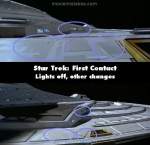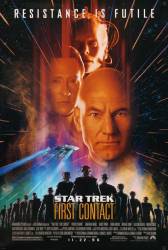Continuity mistake: When patrolling through the Borg-infested corridors, the type of Phaser rifle that Picard as well as other crew members carry changes back and forth from square shaped to curved shaped barrels. (00:31:10 - 00:32:10)
Continuity mistake: As the Enterprise crew walk towards Engineering for the first time, Worf senses the Borg awakening and yells "Ready phasers" before killing a Borg. As that particular drone awakens, we can see it has a needle-like tool coming out of its eye sensor. But when Worf smashes it with his rifle, it has a blue lit-up eye sensor. Furthermore, this drone is seen many times during the following fight sequence after Worf has apparently killed it. (00:35:00)
Continuity mistake: During the Dixon Hill holodeck scene, the room was full of "people" running around while Picard fired the machine gun at the Borg. Yet a few seconds later the room was totally empty. There wasn't enough time for everybody to have abandoned the room. And if it had been a security feature, the entire simulation should have ended, instead of just disabling all the people. (00:54:15)

Continuity mistake: When Picard, Worf, and Hawk step onto the saucer's hull, the camera pans up from the edge showing the path to the deflector (the point at which Picard says "Let's go"). At this point all of the window lights are illuminated on the angled part of the saucer. When it cuts to the wide shot of the hull and the trio having taken half a dozen steps toward the deflector, only the nearest two window lights are illuminated on the angled part of the saucer. Clearly a different model as the aztecing is different, shapes of the hull are different and there is a recess around the yellow RCS thruster in the latter shot. (01:01:10)
Continuity mistake: In the scene where Picard, Worf and Hawk are outside the ship and want to separate the transmitter dish from the hull, Picard must move a kind of tube out of an console and must turn it from a low to a high position. In one shot the tube is in the high position, in the next shot it is in the low position and then Picard pulls it out and turns it in the high position. (01:06:40 - 01:10:35)
Continuity mistake: When Lilly and Jean Luc are arguing in the captain's ready room Jean Luc breaks the glass cabinet holding the gold models of the previous enterprises with one of the Phaser rifles. It only causes the gold model of the Enterprise D to spin 90 degrees on its hook. The next shot both the gold models of the Enterprise C and D are broken in half. (01:20:05 - 01:21:05)
Continuity mistake: When Picard climbs down the ladder next to the broken plasma tube, the break is visible, but there is still glass from top to bottom of the opening. Then, as he walks toward the left of the screen, the break is much larger. (01:37:50)
Continuity mistake: When Worf's spacesuit is cut, a close-up shows it venting from a cut just above the knee. But a wide-shot shows the cut is just below the knee.
Continuity mistake: When Cochrane runs beside a shack to have a nip and get away from the adoring Enterprise crew, he is clean shaven. However, around the time he gets zapped by a stun ray, he now has a significant five o'clock shadow.
Continuity mistake: When Lily points out the unknown object, she lowers her arm. After looking at the falling energy shots, she's lowering her arm again.
Continuity mistake: The number of Borg working on the transmitter dish changes and they move with the speed of light. While Picard explains how they should disable the dish, a shot show that 6 Borg are working on it. They disable 3 in various ways and 1 walks off with Hawk, leaving 2. However, as the disk is being released from the ship there are 3 Borg on it. When Picard disabled his "maglock servo" he avoids capture by a Borg by demagnetizing his boots and flying over it. When he lands at Hawk's earlier position, the Borg is still standing where he left, however a shot seconds later shows the Borg back on the dish.






